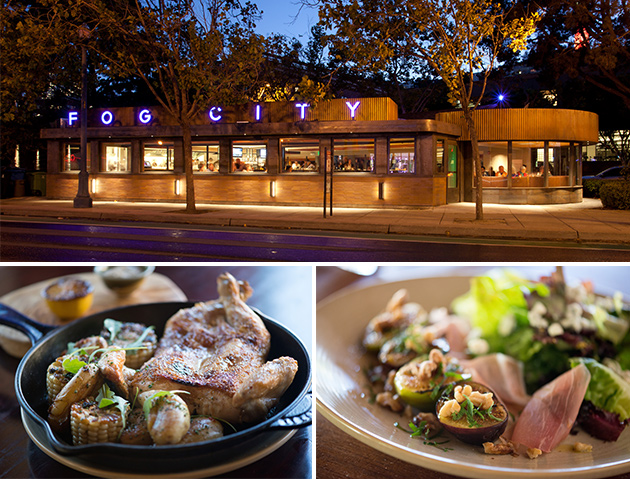In 1985, restaurateur Bill Higgins and chef Cindy Pawlcyn opened a diner at Embarcadero and Battery streets in San Francisco‘s beautiful waterfront district. With an exterior that looked like a modern train car complete with a neon sign, shiny silver swinging doors and black-and-white checkered walls, the restaurant stood out among the fog. At the time, Pawlcyn’s food, international small plates such as red curry mussel stew and grilled chicken with roasted peppers, broke culinary ground. The restaurant, which was even featured in a Visa commercial, quickly became a local and national hot spot.
Pawlcyn left the Fog City Diner more than a decade ago, and with time, the once always-packed eatery lost its luster. In March 2013, Higgins decided to close the restaurant and revamp everything, from the exterior to the food. He brought on a new chef and co-owner, Bruce Hill, who already has a huge local following at Bix Restaurant and Zero Zero, to rethink the menu and food concept. Michael Guthrie, a renowned Bay Area architect, gutted the entire space.
After a six-month remodel, the restaurant, now simply called Fog City, has reopened to much fanfare. The space is decidedly modern with a touch of whimsy — a giant spaceman, which is a piece from Higgins’ art collection, greets diners on the walk to the bathroom. The cumbersome booths and closed kitchen have been replaced with a 2,100-square-foot space, and a V-shaped bar with 30 seats runs down the center of the room. Plus, the loud, active exhibition kitchen is widely visible along the backside of the space. There are 160 seats total, with plenty of seating for large groups, as well as 20 seats outside along Battery Street.
A seven-foot wood-fired grill in the middle of the kitchen makes diners feel as if they are in on the culinary action, and it casts a comforting warmth on the entire restaurant. With a sage, copper and speckled gray color scheme, the décor is earthy and welcoming with a distinctly San Franciscan feel. There is reclaimed wood, plush banquettes and Steelite serving ware.
The menu, which features classic American dishes with a Japanese undertone, is broken up into two sections: snacks and plates to share. Standout snacks include the DuChilly hazelnuts doused in a heavy sprinkling of Spanish paprika, the chilled cucumber dill pickles with housemade ranch, and the blistered Mariquita Farm peppers with Korean sea salt. The menu offers plenty of stellar vegetarian dishes that are complex, flavorful and innovative. For example, the oven-roasted baby carrots with black garlic mole, almonds, and Cotija cheese are an original combination that entices the palate. The seafood dishes are just as interesting: The chilled local oysters are served with a fiery housemade barrel-aged hot sauce, and the pickled shrimp are sweet and succulent. On the meat side, the Fog City burger is sure to be talked about. Everything about it is housemade, from the bun to the smoked tomato aioli to the oozing American cheese. The melt-in-your mouth Berkshire pork cheeks served on a pillow of creamy polenta are a personal favorite. As for the desserts, chef Hill is most excited about the frozen custard, which is a treat that lies somewhere on the creamier side of the ice-cream-to-gelato spectrum. The pure silk, super-dense custard is incredibly rich and satisfying.
Not to be forgotten is lead barman Dustin Sullivan’s inspiring curation of cocktails. The 12 drinks are classic, but with contemporary transformations. The Fog City Milk Punch is made with clarified milk, the rum and citrus of the Dark n’ Stormy Slush is served frozen, and the Bee’s Knees is seasoned with a touch of cinnamon.
Stellar décor, original cuisine and memorable cocktails? The latest incarnation of Fog City is already a hit.
Photos Courtesy of Kristen Loken and Heimo Schmidt

